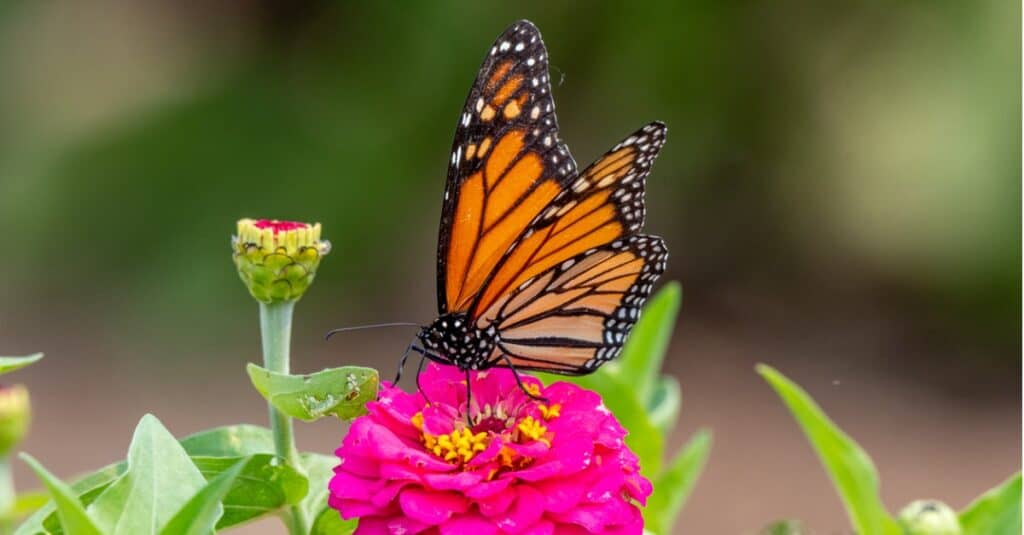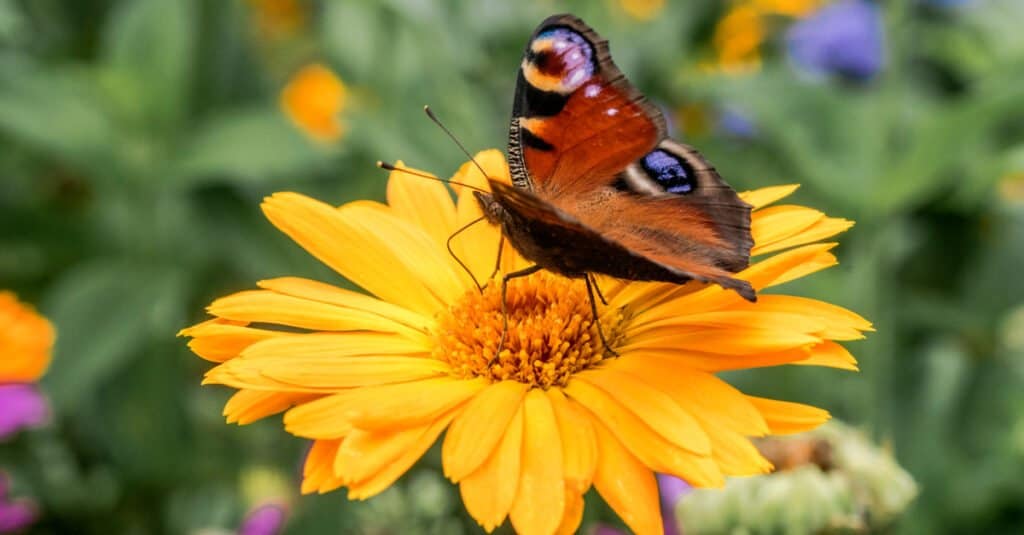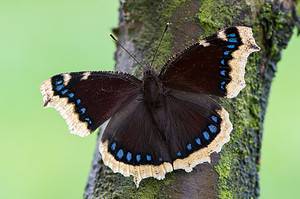When telling a friend about your favorite type of butterfly, you probably start by describing its wings. After all, a butterfly’s wings are its most attractive feature. The wings of these flying insects range in color from simple brown with a few white spots to bright yellow to a glowing bluish-green. We know a lot about a butterfly’s wings, but have you ever taken note of a butterfly’s legs? In a lot of ways, butterfly legs are just as interesting as butterfly wings.
So, how many legs does a butterfly have? Find the answer to this question along with facts about the purpose of a butterfly’s legs, where they are located, and the special way a Monarch butterfly uses two of its legs.

©iStock.com/Christophe Merceron
How Many Legs Does a Butterfly Have?
A butterfly has six legs. Take a close look at the body of a butterfly and you’ll see three sections: a head, a middle area called the thorax, and an abdomen. A butterfly has three legs on each side of its middle section or thorax. This insect has a pair of forelegs in the location nearest its head. Next, are its midlegs and finally its hindlegs located nearest its abdomen.
Each leg has a femur (thigh), a tibia (shin), and a tarsus (foot). As you see, butterfly legs have many of the same parts as human legs!
How Does a Butterfly Use Its Legs and Feet?
Of course, a butterfly uses its legs and feet to walk on a flower, hang from a leaf or climb a tree branch. But there’s an unusual way a butterfly uses its legs and feet.
A butterfly has sensors called chemoreceptors on its legs and feet. In short, butterflies can pick up the taste of a flower, a piece of fruit, or another item just by standing on it. These taste receptors allow them to determine whether they are standing on something they can eat or if they’ve landed on something harmful. Think of this insect’s sensors as similar to the taste buds you have in your mouth.
Do Some Butterflies Have Fewer Than Six Legs?
No. But, Monarch butterflies along with the other members of their family put a little twist on how they use their legs.
Butterflies are classified into one of six families. Those families are the Lycaenidae, Hesperiidae, Nymphalidae, Papilionidae, Pieridae, and Riodinidae. Though all butterflies have six legs, butterflies in the Nymphalidae family use only four of them most of the time.
The Monarch butterfly is a well-known member of the Nymphalidae family. Picture this lovely butterfly with its bright orange and black striped wings working its way through a garden of flowers. If you looked at a Monarch butterfly sitting on a flower you may think it has only four legs. This is because Monarch butterflies and others in the Nymphalidae family, fold both of their forelegs up against their thorax so it looks like they only have four legs. Their forelegs are small with a brush-like texture. This is how these insects earned the name brush-footed butterflies. The butterflies in this family let their midlegs and hindlegs do the walking and climbing.
Why Do Butterflies in the Nymphalidae Family Have Forelegs?
So, if Monarch butterflies and other members of the Nymphalidae family rarely use their forelegs, why do they still have them? Well, though they rarely unfold these legs, they are still useful for a few things. For instance, a Monarch butterfly may use its forelegs for grooming purposes.
When a butterfly in the Nymphalidae family lands on a flower, pollen sticks to its body. The insect delivers some of this pollen to the next flower it visits. This is called pollination. A butterfly with leftover dusty pollen on its body may use its forelegs to clean it off. In other words, these butterflies have a built-in hairbrush!
What Are Prolegs?
Prolegs are the stubby features on the underside of a caterpillar’s body. They are different from this insect’s six true legs. While its true legs help it to walk, a caterpillar’s prolegs are responsible for helping it grab onto stems and leaves so it won’t fall. In some species of caterpillar, their prolegs perform like tiny suction cups on a branch or stem.

©Ian Grainger/Shutterstock.com
How Many Prolegs Does a Caterpillar Have?
It depends. Some species of caterpillar have more prolegs than others. There are some caterpillars with as many as ten prolegs. So, take its ten prolegs and add in its six true legs and you have 16 total. So, the next time you see a caterpillar inching along the stem of a plant, you know it takes two types of legs to get it from point A to point B.
Do Adult Butterflies Have Prolegs?
No. Butterflies don’t have to move along a stem or a leaf-like, caterpillar, so they don’t have prolegs. These stubby legs disappear sometime during the caterpillar’s transformation from larva to pupa to adult butterfly.
Does a Butterfly Really Need Legs?
Yes, a butterfly needs legs. When you picture a butterfly in your mind, you likely picture it flying around in the air or fluttering between flowers. Chances are, you don’t picture a butterfly walking on the ground. But, despite being known for the beautiful colors and designs of their wings, butterflies do need their legs.
Along with having taste sensors in them, butterfly legs are necessary for this insect to take flight. It grasps onto a flower, twig, or branch and starts flapping its wings. As its wing muscles warm up, the butterfly is able to lift off and travel to its next destination.
If a butterfly didn’t have legs, it couldn’t land safely. Furthermore, these insects would have to figure out a way to hang in the air while they drink nectar from flowers or juice from rotten fruit. That would use up too much of this insect’s precious energy.
A butterfly’s legs are necessary for it to rest at night. Most butterflies hang upside down from leaves or twigs while resting after the sun goes down. A butterfly isn’t able to fly around at night because there’s no sunlight to give it the warmth and energy it needs to function. Don’t forget, butterflies are cold-blooded so they can’t maintain a normal body temperature. These insects can only warm themselves as the environment around them warms up.
A male and female must land on a leaf or stem before they can mate. This means a butterfly’s legs are essential in the reproduction of the species. In addition, a female butterfly uses its legs and feet to investigate different types of plants to find the best place to lay her eggs. When the eggs hatch, she wants to make sure that the emerging caterpillars have plenty to eat so they can complete the lifecycle by eventually transforming into adult butterflies.

Viewing a close-up photo is one safe way to study the legs of a butterfly without harming it.
©Nick Pecker/Shutterstock.com
How Can You Examine a Butterfly’s Legs Without Harming It?
Studying the legs of a butterfly can be a challenging task. These insects always seem to be on the move! A butterfly’s legs and wings are very delicate. So, it’s best to avoid trying to capture and hold this insect. But there are some ways to study them without risking their safety.
One idea is to cut some oranges in half and put them in a bowl with the fleshy side facing upward. Next, put the bowl near a window where you can watch butterflies gather and land on the oranges to drink the fruit juice. If you make very little movement, the butterflies may remain at the orange bowl long enough for you to study their legs. If you can take a photo of the butterflies with your phone, you may be able to zoom in on the image to get a closer look.
Look for a butterfly exhibition in your area. This type of exhibition is a place where people can go to look at all types of butterflies moving around in a natural habitat. Many of these exhibitions provide visitors with orange slices or other fruit that will encourage butterflies to land on them. This is a great way to see the details of a butterfly’s wings and legs. Of course, if a butterfly does land on your orange slice, just look at it without trying to touch it.
Caring for a butterfly cocoon gives you a close-up look at the parts of a butterfly. You can purchase butterfly cocoons that arrive with instructions on how to care for them in an aquarium in your home. So, you’re right there when the butterfly emerges from its cocoon! These butterflies can be released outdoors when they are ready to fly.
Monarchs now Classified as Endangered
The eastern migratory Monarch butterfly population has decreased by 80% over the last three decades, and has been classified as “endangered” by the International Union for Conservation of Nature (IUCN). One of the main reasons for the decline is the use of herbicides, resulting in the loss of milkweeds, which are necessary for monarch’s reproduction. Climate change and forest degradation are also to blame, although efforts toward sustainability and collaborations with local communities in Mexico have kept the forest degradation threat at bay.
Up Next…
- What Flowers Attract Butterflies?: Check out our complete guide before planting your butterfly garden!
- Butterfly Predators: What Eats Butterfly?: These beautiful creatures are not at the top of the food chain. Discover what preys on butterflies!
- Monarch Butterfly Lifespan: How Long Do Monarch Butterflies Live?: Find out more about the endangered Monarch by reading this informative article!
- Do Butterflies Drink Blood? And 13 More Surprising Butterfly Facts: You will be shocked when you read this!
The photo featured at the top of this post is © iStock.com/ktreffinger
Thank you for reading! Have some feedback for us? Contact the AZ Animals editorial team.






